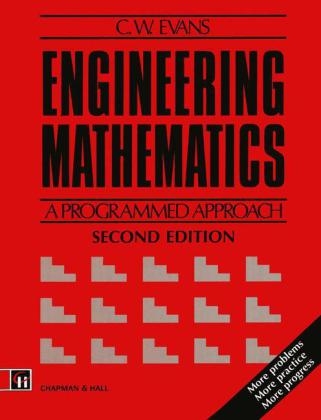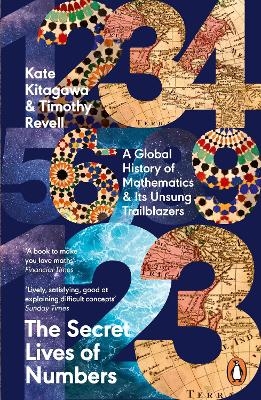
Engineering Mathematics
Springer-Verlag New York Inc.
978-1-4684-1414-1 (ISBN)
- Titel ist leider vergriffen;
keine Neuauflage - Artikel merken
Neverthe- less by the end of the first year of study all of them must have achieved a minimum standard in mathematics and also have acquired sufficient skill to enable them to cope with the more advanced mathematical topics in the second year. Experience has shown that many students are unable to cope with the traditional mathematics textbooks because they find them remote and the concepts difficult to handle.
1 Numbers and logarithms.- 1.1 Numbers.- 1.2 Real numbers.- 1.3 Workshop.- 1.4 The real number system.- 1.5 Indices and logarithms.- 1.6 The binomial theorem.- 1.7 Workshop.- 1.8 Practical.- Summary.- Assignment.- Further exercises.- 2 Sets and functions.- 2.1 Set notation.- 2.2 Real intervals.- 2.3 Workshop.- 2.4 Functions.- 2.5 Workshop.- 2.6 Identities and equations.- 2.7 Polynomials and rational functions.- 2.8 Partial fractions.- 2.9 Workshop.- 2.10 Practical.- Summary.- Assignment.- Further exercises.- 3 Trigonometry and geometry.- 3.1 Coordinate systems.- 3.2 Circular functions.- 3.3 Trigonometrical identities.- 3.4 The form a cos ? + b sin ?.- 3.5 Solutions of equations.- 3.6 Workshop.- 3.7 Coordinate geometry.- 3.8 The straight line.- 3.9 The circle.- 3.10 The conic sections.- 3.11 Workshop.- 3.12 Practical.- Summary.- Assignment.- Further exercises.- 4 Limits, continuity and differentiation.- 4.1 Limits.- 4.2 The laws of limits.- 4.3 Workshop.- 4.4 Right and left limits.- 4.5 Continuity.- 4.6 Differentiability.- 4.7 Leibniz's theorem.- 4.8 Techniques of differentiation.- 4.9 Workshop.- 4.10 Logarithmic differentiation.- 4.11 Implicit differentiation.- 4.12 Parametric differentiation.- 4.13 Rates of change.- 4.14 Workshop.- 4.15 Practical.- Summary.- Assignment.- Further exercises.- 5 Hyperbolic functions.- 5.1 Definitions and identities.- 5.2 Differentiation of hyperbolic functions.- 5.3 Curve sketching.- 5.4 Workshop.- 5.5 Injective functions.- 5.6 Surjective functions.- 5.7 Bijective functions.- 5.8 Pseudo-inverse functions.- 5.9 Differentiation of inverse functions.- 5.10 The inverse circular functions.- 5.11 Workshop.- 5.12 The inverse hyperbolic functions.- 5.13 Practical.- Summary.- Assignment.- Further exercises.- 6 Further differentiation.- 6.1 Tangents and normals.- 6.2 Workshop.- 6.3 Intrinsic coordinates.- 6.4 The catenary.- 6.5 Curvature.- 6.6 Workshop.- 6.7 Practical.- Summary.- Assignment.- Further exercises.- 7 Partial differentiation.- 7.1 Functions.- 7.2 Continuity.- 7.3 Partial derivatives.- 7.4 Higher-order derivatives.- 7.5 Workshop.- 7.6 The formulas for a change of variables: the chain rule.- 7.7 The total differential.- 7.8 Workshop.- 7.9 Practical.- Summary.- Assignment.- Further exercises.- 8 Series expansions and their uses.- 8.1 The mean value property.- 8.2 Taylor's theorem.- 8.3 Workshop.- 8.4 L'Hospital's rule.- 8.5 Workshop.- 8.6 Maxima and minima.- 8.7 Workshop.- 8.8 Practical.- Summary.- Assignment.- Further exercises.- 9 Infinite series.- 9.1 Series.- 9.2 Convergence and divergence.- 9.3 Tests for convergence and divergence.- 9.4 Power series.- 9.5 Workshop.- 9.6 Practical.- Summary.- Assignment.- Further exercises.- 10 Complex numbers.- 10.1 Genesis.- 10.2 The complex plane: Argand diagram.- 10.3 Vectorial representation.- 10.4 Further properties of the conjugate.- 10.5 De Moivre's theorem.- 10.6 Workshop.- 10.7 The nth roots of a complex number.- 10.8 Power series.- 10.9 Workshop.- 10.10 Practical.- Summary.- Assignment.- Further exercises.- 11 Matrices.- 11.1 Notation.- 11.2 Matrix algebra.- 11.3 Workshop.- 11.4 Matrix equations.- 11.5 Zero, identity and inverse matrices.- 11.6 Algebraic rules.- 11.7 Practical.- Summary.- Assignment.- Further exercises.- 12 Determinants.- 12.1 Notation.- 12.2 Cramer's rule.- 12.3 Higher-order determinants.- 12.4 Rules for determinants.- 12.5 Workshop.- 12.6 Practical.- Summary.- Assignment.- Further exercises.- 13 Inverse matrices.- 13.1 The inverse of a square matrix.- 13.2 Row transformations.- 13.3 Obtaining inverses.- 13.4 Systematic elimination.- 13.5 Workshop.- 13.6 Pivoting.- 13.7 Practical.- 13.8 Concluding remarks.- Summary.- Assignment.- Further exercises.- 14 Vectors.- 14.1 Descriptions.- 14.2 Vector addition.- 14.3 Scalar multiplication.- 14.4 Components.- 14.5 The scalar product.- 14.6 Direction ratios and direction cosines.- 14.7 Applications.- 14.8 Algebraic properties.- 14.9 The vector product.- 14.10 Workshop.- 14.11 The triple scalar product.- 14.12 The triple vector product.- 14.13 Differentiation of vectors.- 14.14 Workshop.- 14.15 Practical.- Summary.- Assignment.- Further exercises.- 15 Integration 1.- 15.1 The concept of integration.- 15.2 Rules for integration.- 15.3 Workshop.- 15.4 Integration by inspection.- 15.5 Integration by partial fractions.- 15.6 Integration by parts.- 15.7 Workshop.- 15.8 Practical.- Summary.- Assignment.- Further exercises.- 16 Integration 2.- 16.1 Integration by substitution.- 16.2 Workshop.- 16.3 Special substitutions.- 16.4 Integration using standard forms.- 16.5 Reduction formulas.- 16.6 Workshop.- 16.7 Practical.- Summary.- Assignment.- Further exercises.- 17 Integration 3.- 17.1 Definite integration.- 17.2 Improper integrals.- 17.3 Area under the curve.- 17.4 Volume of revolution.- Workshop.- 17.5 Length of a curve.- 17.6 Centres of mass.- 17.7 The theorems of Pappus.- 17.8 Moments of inertia.- 17.9 The perpendicular axis theorem.- 17.10 The parallel axis theorem.- 17.11 Average values.- 17.12 Radius of gyration.- 17.13 Practical.- Summary.- Assignment.- Further exercises.- 18 Numerical techniques.- 18.1 The solution of the equation f(x) = 0.- 18.2 Graphical methods.- 18.3 Iterative methods.- 18.4 The bisection method.- 18.5 The regula falsi method.- 18.6 The secant method.- 18.7 Newton's method.- 18.8 Workshop.- 18.9 Approximations to derivatives.- 18.10 Workshop.- 18.11 Numerical integration.- 18.12 The trapezoidal rule.- 18.13 Simpson's rule.- 18.14 Workshop.- 18.15 Practical.- Summary.- Assignment.- Further exercises.- 19 First-order differential equations.- 19.1 Terminology.- 19.2 Variables separable equations.- 19.3 Workshop.- 19.4 Linear equations.- 19.5 Workshop.- 19.6 Bernoulli's equation.- 19.7 Homogeneous equations.- 19.8 Workshop.- 19.9 Reducible equations.- 19.10 Boundary conditions.- 19.11 Practical.- Summary.- Assignment.- Further exercises.- 20 Second-order differential equations.- 20.1 Linear differential equations.- 20.2 The homogeneous case.- 20.3 Workshop.- 20.4 The non-homogeneous case.- 20.5 The particular solution.- 20.6 Workshop.- 20.7 The breakdown case.- 20.8 Workshop.- 20.9 Higher-order equations.- 20.10 Damping.- 20.11 Resonance.- 20.12 Transient and steady state.- 20.13 Practical.- Summary.- Assignment.- Further exercises.- 21 Difference equations.- 21.1 Variables.- 21.2 The homogeneous case.- 21.3 The auxiliary equation.- 21.4 Workshop.- 21.5 The non-homogeneous case.- 21.6 The particular solution.- 21.7 The breakdown case.- 21.8 Workshop.- 21.9 Practical.- Summary.- Assignment.- Further exercises.- 22 linear operators.- 22.1 Linear functions.- 22.2 Vector spaces.- 22.3 The addition rules.- 22.4 The scalar multiplication rules.- 22.5 Linear combinations.- 22.6 Linear dependence.- 22.7 Linear independence.- 22.8 Bases.- 22.9 The basis theorem.- 22.10 Transformations.- 22.11 The zero and identity operators.- 22.12 Linear operators.- 22.13 Algebraic rules for operators.- 22.14 Inverse operators.- 22.15 The operational method.- 22.16 Workshop.- 22.17 Practical.- Summary.- Assignment.- Further exercises.- 23 Descriptive statistics.- 23.1 Terminology.- 23.2 Random samples.- 23.3 Population statistics.- 23.4 Data.- 23.5 Pictorial representations.- 23.6 Pie charts.- 23.7 Bar charts.- 23.8 Histograms.- 23.9 Grouped data.- 23.10 Cumulative frequency diagrams.- 23.11 Measures of location and measures of spread.- 23.12 The mean.- 23.13 The mode.- 23.14 The median.- 23.15 The range.- 23.16 The mean absolute deviation.- 23.17 The standard deviation.- 23.18 Workshop.- 23.19 Practical.- Summary.- Assignment.- Further exercises.- 24 Probability.- 24.1 Concepts.- 24.2 The rules of probability.- 24.3 The sum rule.- 24.4 Mutually exclusive events.- 24.5 Conditional probability.- 24.6 The product rule.- 24.7 Independent events.- 24.8 Complementation rule.- 24.9 A random variable.- 24.10 The analytical method.- 24.11 The relative frequency method.- 24.12 The mathematical method.- 24.13 The binomial distribution.- 24.14 The mean of a probability distribution.- 24.15 The variance of a probability distribution.- 24.16 The Poisson distribution.- 24.17 Approximation for the binomial distribution.- 24.18 Continuous distributions.- 24.19 Mean and variance.- 24.20 The normal distribution.- 24.21 Discrete approximations.- 24.22 Continuity correction.- 24.23 Normal probability paper.- 24.24 Workshop.- 24.25 Practical.- Summary.- Assignment.- Further exercises.- Hints and solutions.- Symbols index.
| Verlagsort | New York, NY |
|---|---|
| Sprache | englisch |
| Maße | 189 x 246 mm |
| Einbandart | Paperback |
| Themenwelt | Schulbuch / Wörterbuch |
| Mathematik / Informatik ► Mathematik ► Geschichte der Mathematik | |
| Naturwissenschaften | |
| Technik | |
| ISBN-10 | 1-4684-1414-3 / 1468414143 |
| ISBN-13 | 978-1-4684-1414-1 / 9781468414141 |
| Zustand | Neuware |
| Informationen gemäß Produktsicherheitsverordnung (GPSR) | |
| Haben Sie eine Frage zum Produkt? |
aus dem Bereich


